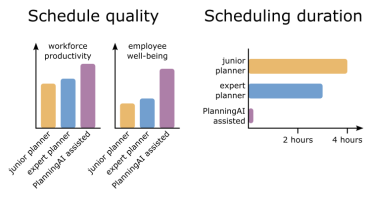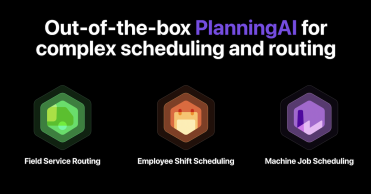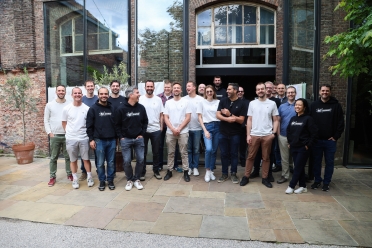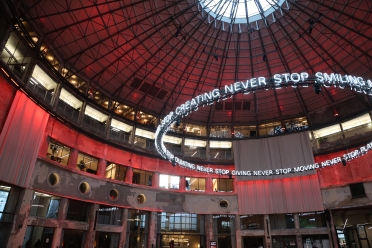Summary
- The hobby project
- The day job
- The dream
- The engineering team
- The gold vein
- The acquisition
- The breakdown
- The marriage conversation
- The business model
- The advice
- The investor
- The cofounder
- The leap
- The company
- The AI hype
- The pre-seed funding
- The fork
- The Product Market Fit
- The platform
- The startup team
- The seed funding
- The circus
- The SaaS launch
- The Go To Market
- The future
Stay in the know.
Subscribe to Planned, planning education for real-world stuff.
On this day, 3 years ago, my world fell apart. It was a Thursday. I just finished my second meeting that morning, looked at my inbox and realized it was over. My life’s work was over. OptaPlanner, the popular open source solver we had developed and refined for more than a decade, was going to die. Despite worldwide success on thousands of projects.
I curled into the sofa. Two hours later, my wife found me there, still catatonic.
This is the story of Timefold AI.
This is the story of how I turned a doomed open source project into a fast-growing PlanningAI company.
With commercial success. Without sacrificing our open source values. With a clear goal: free the world from wasteful scheduling.
# The hobby project
19 years ago, a colleague showed me his shift rostering project. To make it fast enough, his code had become unreadable and unmaintainable. It wasn’t his fault. The solver software forced his hand. I envisioned a better Solver API design that would prioritize ease-of-use. So in the summer of 2006, I created an open source project to solve planning problems. Nothing serious, just a hobby.
I released it under the Apache License and kept improving it. Over the years, I added more features, examples, documentation and testing. Good engineering practices. Marketing matters too, so I published articles and presented at conferences about it.
It turns out that good documentation is a superpower for open source projects.
By 2012 my hobby project had grown into a software library with deep tech algorithms for vehicle routing problems (VRP), employee rostering, job shop scheduling, and many other Operations Research challenges. Enterprise projects started using it. Even a NASA supplier for satellite scheduling. But it was far from perfect.
Meanwhile, I got married, renovated an old house and struggled to find time for my hobby project. With kids underway, I quickly started running out of spare time to work on it…
You can’t build a world-class product as a hobby.
# The day job
By contributing to open source projects, I landed a job at Red Hat, the open source company. I loved working there. By 2013, they wanted to productize my work, so we renamed it to OptaPlanner and Red Hat started selling support for it.
My hobby became my work.
Customers needed help. I honed my talent for modeling enterprise planning problems. I got to work on all kinds of cases, such as routing thousands of field service technicians, scheduling maintenance of airplanes and planning production in factories across the globe. This feedback also shaped my software immensely.
Regularly talking to real users is critical. One real business problem is worth a thousand academic ideas.
# The dream
I realized that the world is full of planning problems. Some are automated. Few are optimized.
I still estimate that 95% of companies use a drag-and-drop scheduling UI or mess around in Excel. Great algorithms have existed for decades. But they are too hard to use. I made it my life’s mission to fix that.
Because real-world planning problems are complex. To solve them with ease, my software needed to evolve faster and broader. I needed a team.
You can’t build a world-class product alone.
# The engineering team
Luckily the OptaPlanner team grew organically as Red Hat sold support subscriptions. Great minds like Lukas, Radek and Chris joined me. We didn’t always agree immediately, so we worked out a meeting process to fine-tune design proposals, without drama.
In hindsight, alignment was easy: we were all engineers.
Lukas became my right hand. He probably answered more StackOverflow questions than me. As I (slowly) learned to share ownership, to let go, the project started taking big leaps forward. Our solver finally became easy to use.
Meanwhile, users reported ROI (return on investment) numbers that surpassed our wildest dreams…
# The gold vein
Most companies don’t expect big gains from planning optimization. They think their manually planned schedules are near-optimal. But they’re wrong. In vehicle routing cases, our solver helps planners to reduce their fleet’s travel time by 25%. For big companies, this saves a hundred million dollars per year. And ten million kg of CO² emissions per year. It gives the world extra time.
So clearly, there’s money to be made with this technology. But our software was 100% open source: Red Hat only sold support. That’s a weak Value Proposition. Especially if there are almost no bugs, support is worthless. I estimate 0.01% of our users paid. Enough to keep the lights on. But not enough to free the world from wasteful scheduling.
Without a proper business model, an open source project doesn’t change the world.
We needed repeatable sales. A great engineering team is not enough. To turn the gold vein into a gold mine, we needed a commercial team focussed on selling to Planning Optimization customers. But that wasn’t the corporate strategy…
You can’t build a world-class product without sales and marketing.
# The acquisition
IBM acquired Red Hat in 2019. Initially, everybody got nervous, especially because they owned a competing solver. But after a year, everything seemed normal.
At the end of 2021, I distinctly remember telling my team: “We’re safe. OptaPlanner pays for itself. Red Hat would be crazy to kill our project.” But our project’s revenue was part of a broader product subscription…
# The breakdown
By then it was February 2022 - that fateful week three years ago.
On Monday, they told us that the product subscription would move to IBM, without us. It didn’t fit in the strategy.
The first stage is Denial.
On Tuesday, they told the entire company. Every Red Hat sales with an OptaPlanner deal in the pipeline contacted me. They needed a product to sell. But I had no answers.
The second stage is Anger.
On Wednesday, I wanted to rescue the sales pipeline. Months of work. I pleaded with management to move us into another product and to announce it immediately. But it’s not that simple.
The third stage is Bargaining.
On that fateful Thursday, I looked at my inbox and crashed.
The fourth stage is Depression.
Much later, I realized Red Hat made the right decision. A company needs focus. When your company strategy is Hybrid Cloud, your marketing, sales and support teams aren’t experienced (nor incentivized) to deal with scheduling or routing problems too.
The last stage is Acceptance.
# The marriage conversation
After my wife found me there, curled up on the couch, I had to get healthy first. When I was back on my feet, I regressed through those stages a few times. It was my life’s work hanging in the balance. But by July 2022 all hope died: it was clear that OptaPlanner had no future.
What if I start my own company around the open source project? Without thinking too much about it, I floated the idea to my wife…
My wife grew up with self-employed parents that worked day and night. She knew the sacrifices to run your own business. She never wanted that for our family. And with two kids and a big mortgage, my salary was needed to pay the bills. So imagine my surprise when - without batting an eyelid - she replied:
“Go for it! We can handle a year without your income.”
No doubt. No resistance. Only optimism. She knows this is my life’s work and she respects that. She mentally even took the leap faster than I did. She’s truly a wonderful woman.
To create a successful startup, you need support from your spouse.
# The business model
By then, my reputation as a planning expert preceded me. I could automate any scheduling problem and make it scale (on our solver). So I could start a consulting company and sell my time by the hour. Easy money. But then I would be working on the solver in my spare time again.
“You can’t build a world-class product as a hobby.”
Instead, I had to build a product company. One that offers a subscription on top of the open source project. With a strong value proposition. Support alone wasn’t enough, so I decided to go for the open core business model: keep developing the open source solver, but sell proprietary services on top of it. I couldn’t build all that alone. And software developers don’t work for free.
“You can’t build a world-class product alone.”
Bootstrapping would take too long. I needed an investor. Not an Angel Investor that wants a reliable return, but a VC firm that’s in it for the long run and wants to take an ambitious, big risk. But I didn’t know how to build a startup. Nor fund it.
“You can’t build a world-class product without sales and marketing.”
Luckily, I live in Ghent - a strong startup hub in Europe.
# The advice
A solo entrepreneur advised me: “Don’t do it alone”. Purely for mental reasons. You need someone to not just share, but also understand the hardship and complexity. A cofounder. Not an employee, not an adviser, but someone who’s all-in. He was right.
A few dozen people had asked me to start a company before. They all dreamt of riches and success, but none had startup experience. Neither did I.
I started reading books. The Founder’s Dilemma was highly informative. I realized I needed a CEO. Someone with experience on how to run a company. Someone with a very different skillset and different mindset than myself. The science is clear: cofounders need to complement each other. Balance each other out. And challenge each other.
So how could I find an experienced startup CEO?
# The investor
A friend of mine put me in contact with Thomas, an investor of Smartfin.
I sent him a convincing email and we met up at a local coffeehouse for a 30 minute meeting. There are rules on how to pitch to an investor. I didn’t know any of them. I followed none and I don’t recommend that. Yet, he kept listening and recognized the value. After talking for two hours, I asked him to connect me to a potential CEO.
It turns out that Smartfin is the biggest seed-stage VC investor in Belgium.
After that meeting, Thomas called Maarten - a serial entrepreneur mastermind - and told him “I’ve just heard an interesting pitch from a technical guy, but this is not investment ready.”
In hindsight, I was clueless on how to build a company.
# The cofounder
In September 2022, I met Maarten for the first time. Through some freak coincidence he lives three streets away from me. He’d probably call it destiny.
I wanted a CEO with expertise in sales and administration.
I found a CEO with expertise in venture building, hiring, funding and a bit of sales.
I didn’t get what I wanted, I got what I needed. As a founder, he had built 3 companies from the ground up already. That left wisdom and battle scars.
Because a seasoned founder doesn’t look at a startup idea like normal people. They see the pain. They question the Product Market Fit. They are brutally critical and despise wishful thinking, because without revenue, the startup dies. Ideas are cheap, execution is expensive.
Maarten’s favorite line: “Assumption is the mother of all fuckups.”
In our sparring sessions, we worked out a plan and focussed on the pain points. I didn’t always understand him. Nor did he me. We often still don’t. I haven’t led a company through financial hardship before and he hasn’t seen how technical debt compounds on long-term software like terminal cancer. But we learned to trust each other. To listen to each other, especially when we don’t agree.
After a month, we took the leap.
# The leap
Every founder needs to take the leap: exchange predictable income for uncertainty.
For me, that came in October: I resigned from Red Hat and invested part of our family’s savings in the company. The rest of our savings steadily eroded each month. The clock was ticking. Work-life balance went out the window.
Fun fact: 90% of startups fail.
# The company
On December 8th, 2022 Maarten and I registered our company. We named it Timefold, because we like to say that our algorithms fold space and time.
Afterwards we got breakfast and Maarten announced to the entire restaurant: “We just got married!” There’s truth in that.
One of our first expenses went to a designer to create an elegant logo:

# The AI hype
After ChatGPT came out, every company needed an AI story. Including our potential customers. Investors loved it too. Should we ride the AI wave?
Timefold’s algorithms are categorized as Artificial Intelligence. But its core is not a Large Language Model or even Machine Learning. It doesn’t use training data. It will never evolve into an AGI. But it’s unrivaled at optimizing planning and scheduling.
I’d even argue it’s a superintelligence because the results leapfrog human capabilities:

We decided to capitalize on the buzz and registered timefold.ai. Later we coined the term PlanningAI.
# The pre-seed funding
We needed money to hire a team. Maarten got us in front of every notable VC investor in Belgium.
VC firms collect a large pool of money and invest it in startups. They prefer startups with billion dollar potential, to cover losses on startups that go bankrupt. High risk, high reward. They play the long game. They’ve seen first-hand the growth challenges and impact of strategic decisions for dozens of companies at various stages. Their advice is invaluable. So is their network.
Here’s how it works: a VC typically takes a 20-25% stake. The amount of money varies. They don’t mind a 10% ESOP pool for employee shares. Founders might get a wage to avoid personal financial stress, but then also need skin in the game, typically by investing personally. The VC takes a seat on the board, but doesn’t meddle in day-to-day management. They mainly advise on C-suite hires and strategic company direction. It’s a good deal, but they won’t do the work for you.
What about open source? I didn’t want to end up with a bait-and-switch on my hands. Not every VC gets it, but many VCs respect the distinct advantage of open core companies in the developer API market.
Smartfin did. They offered us the most money and a wise, experienced director for the board. So we accepted their term sheet and went through the due diligence period.
At this point, we were basically two guys with an idea. In March 2023 - six months after I resigned - we closed the deal and they gave us a cool 2 million euro.
Afterwards we got lunch and Maarten asked them:
“How many cases do you get per year?”
“About 1200.”
“And how many do you fund?”
“Two. Maybe three.”
Maarten and I looked at each other. Only 0.25%. I still remember the expression on his face: flabbergasted.
# The fork
In May, we came out of stealth. We forked OptaPlanner as Timefold Solver and told the world. Soon after, we talked to prospects and by the end of summer we landed our first big customer.
Meanwhile, the original OptaPlanner team joined Timefold. We were back in business!
# The Product Market Fit
But sales were rare. We had plenty of inbound - companies using our open source solver in production - but few that saw enough reason to buy. Our Value Proposition was still too weak.
Companies fail because they fail to achieve Product Market Fit.
PMF is almost holy for startups. Maarten obsessed on these two questions:
1) Do people want to use it?
2) Do people want to pay for it?
Most founders fool themselves on these simple questions. I assumed because our solver saves our users a ton of money, they’ll happily pay for it. But assumption is the mother of … Well, I was wrong.
To become viable, we needed a stronger proprietary offering on top of the open source solver. Without crippling the solver.
# The platform
The obvious answer was to build a cloud SaaS platform. Almost every other successful open source company did that. But the devil is in the details.
One of our first hires was magic: a next level cloud architect that helped me deliver Employee Shift Scheduling as a docker REST service for an early customer. He started building an efficient architecture to orchestrate solver runs in the cloud. This became the Timefold Platform.
But customers aren’t looking to buy a platform. They’re looking to buy a solution for their problem. Their planning problem. So we created REST APIs for common planning problems - such as Field Service Routing and Employee Shift Scheduling - and deployed them as PlanningAI models on our platform:

As we were building up these teams - Solver, Platform, Models and Solutions - we needed to become a real company.
# The startup team
Every aspect of building a startup is a world of expertise on its own. And if you mess up one part, it affects the whole startup. I had many roles and I wasn’t an expert at most of them. Maarten too. So we hired bright leaders who did it better, mostly from the Ghent tech scene.
For me personally, this started one of the hardest periods of my career.
Over the course of a year, one by one, many of my responsibilities were taken away and given to new hires.
I felt like I was losing control.
I wasn’t.
I felt like I could do those jobs better myself.
I couldn’t.
My role was cut up into our:
- Head of Engineering that organizes a steady pace of progress and doesn’t even blink under stress
- Head of Product that tracks everything and deeply understands that a product is more than code
- Head of Customer Success that groks complex constraints and speaks business too
- Head of Marketing that wrote the most crisp copy on what my tech does that I’ve ever seen
Maarten went through this too, but he had gone through this several times.
He delegated responsibilities to our Chief Commercial Officer (CCO) and Chief Financial Officer (CFO).
Smart, experienced people - each and everyone of them - but still our new leadership team went through growing pains. For me personally, alignment felt hard: they were not all engineers. Luckily! Otherwise the company wouldn’t thrive. Or even survive.
With this leadership in place, we’ve handpicked a team of 30+ specialists, each experts in their domains, dedicated to share our planning solutions with the world:

Together, we've built Timefold.
# The seed funding
By mid 2024, our cloud product took shape. It was still a beta version, but a few select customers already used our scheduling and routing APIs in production.
Yet, revenue was still low. There was no real sales organization yet. We needed to build the product, before we could sell it. To continue that, we needed extra funding.
There is no middle ground between Bootstrapping and VC funding. Once you take the VC path, it’s natural to raise multiple rounds of funding, such as seed, series A and series B. The ambition is to grow and carve out a path to profitability.
This time, we pitched internationally. As an AI SaaS platform with deep tech, we got a good deal of attention. We ended up signing with Lakestar, one of Europe’s top VC firms. This got us another 6 million euro in the bank and an extra board director who can hustle us an intro to strategic customers and advisors.
# The circus
Up to that point, our office was an orangerie, an old greenhouse building in Maarten’s garden. Good enough for a remote-first company. Better than a garage. But between the thorny plants, we ran out of space.
So in September 2024, we moved to the Wintercircus, a huge 130-year old building in the center of Ghent that is now the heart of the startup scene in Belgium.

# The SaaS launch
In October 2024 we launched our SaaS platform app.timefold.ai, with REST APIs for Vehicle Routing Problems and Employee Rostering. Soon we’ll add Production Scheduling. And it never crashed. Even now, as enterprise customers hammer it daily to solve big datasets with tens of thousands of employees.
Meanwhile, our solver team made the open source solver remarkably faster, based on feedback from the community and our models team. It’s amazing what “eating your own dog food” can do for a company.
# The Go To Market
We also began our outbound marketing campaigns. Meanwhile, our account and solutions teams worked out how to make our customers successful quicker.
Personally, I started posting on my LinkedIn account on how to approach complex scheduling and routing in the real-world. In a just few months, I became a well-known voice in the Operations Research community.
But honestly, we’re still fine-tuning our Go To Market. When it's fully polished, maybe I can write another article about that? It’s good marketing!
# The future
This isn’t the entire story of Timefold. This is just my part of the story. Others did far more for Timefold than I could depict here. And our users made the real impact, by applying our technology on thousands of cases.
This is only the beginning.
Our technology is ready.
Our company is thriving.
Our roadmap is ambitious. More on that coming soon.
Our community is geared up. Join us, and subscribe to the newsletter in the footer.
Our APIs are thoroughly documented. Explore it for yourself.
Now is the time to free the world of wasteful scheduling!



